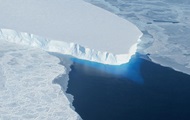Photo: NASA
Catastrophic glacier collapse could begin due to collapse under its own weight
–
–
Its destruction will provoke a significant rise in sea level, threatening the entire coastal part of humanity.
Scientists from the University of Michigan and St Andrews University spoke about the potential future of the Thwaites Glacier. The results of the research are published in the journal Science. writes Lenta.ru June 21.
Thwaites is also known as the Doomsday Glacier due to the fact that its destruction will provoke a significant rise in sea level, which threatens the entire coastal part of humanity.
Catastrophic destruction of the glacier can begin due to the collapse under its own weight of ice located on the border between the glacier and the ocean. This mechanism, called sea ice cliff instability or MICI, was recently proposed by scientists, and arises from the fact that the height of the ice cliffs is determined by the strength of the ice.
As the thickness of the glacier grows upstream, with each collapse (hotel) there is an even higher ice edge. The result is a chain reaction of collapse, leading to a catastrophic retreat of the glacier within just one century.
Although MICI is not observed in modern ice sheets, there is evidence that this happened in antiquity.
On the edge of the abyss. After COVID, the environment will worsen
In the new work, scientists have demonstrated that, contrary to the hypothesis of instability, ice cliffs, the height of which exceeds the maximum allowable level, will not always undergo a chain reaction of collapse. A catastrophe occurs only when the gradient of the ice thickness, which grows as it approaches the coast, exceeds a certain critical limit.
In particular, scientists, taking into account the contribution of ice viscosity, created a computer model of a glacier with an ice cliff height of 800 meters with a ground line (point of contact with the ocean floor – ed.) At a depth of 690 meters, which is comparable to the largest glaciers in Greenland and the Thwaites and Pine glaciers. Island in Antarctica.
The calving of the above-water part of the glacier leads to the appearance of icebergs, however, at the same time, a huge underwater part of the glacier breaks off and floats up, starting to play the role of a support that stabilizes the instability of the ice cliff and slows down the retreat of the glacier.
The situation changes with changes in the slope of the bottom and the speed of the glacier current. When the critical limit is exceeded, chain collapse can occur at a speed exceeding tens of kilometers per year.
However, even when a catastrophic regime becomes imminent, slight pressure from icebergs, sea ice or fast ice can suspend MICI.
The Thwaites Glacier, located in the Amundsen Sea in West Antarctica, is considered one of the glaciers most vulnerable to rock chain collapse.
The collapse or weakening of the floating ice shelf due to climate change, which currently supports the Thwaites Glacier, will expose an ice rock large enough to initiate MICI.
The authors of the study showed that although in this case a chain reaction of collapse will not initially occur (due to the features of the bottom topography), climate change will still lead to a gradual retreat of the glacier by several kilometers per year and, consequently, a slow rise in sea level.
In May, it was reported that it broke away from Antarctica the world’s largest iceberg… The giant object was discovered by British and American scientists who analyzed images from an Earth observation apparatus. Its area is approximately 4,320 square kilometers.
News from Correspondent.net in Telegram. Subscribe to our channel https://t.me/korrespondentnet
– .


